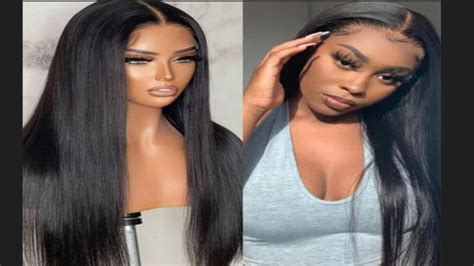Introduction

If you’re seeking a versatile and transformative hair solution, wigs and half wigs offer a plethora of options to enhance your style and confidence. Explore the world of these hairpieces and discover the endless possibilities they hold.
Understanding Wigs and Half Wigs
Wigs:
Wigs are complete head coverings that conceal your natural hair, providing a full and seamless transformation. They come in various lengths, styles, and colors, allowing you to experiment with different looks effortlessly.
Half Wigs:
Half wigs, also known as hair toppers or falls, are partial wigs that cover the top or back of your head. They provide volume, fullness, and a natural-looking appearance while leaving your natural hair exposed around the perimeter.
Benefits of Wigs and Half Wigs
- Versatile Style Options: Wigs and half wigs offer a wide range of styles, from classic bobs to cascading curls. Experiment with different looks to suit any occasion.
- Hair Loss Solutions: For individuals experiencing hair loss due to medical conditions or aging, wigs and half wigs can restore fullness and confidence.
- Convenience: Wigs are convenient for those who want a quick and effortless hair transformation without the commitment of permanent coloring or extensions.
- Protective Style: Half wigs can protect natural hair from heat damage and breakage by shielding it from styling tools and environmental elements.
Common Mistakes to Avoid
- Choosing the Wrong Size: Ensure you measure your head circumference accurately before selecting a wig. An ill-fitting wig can be uncomfortable and unflattering.
- Lack of Maintenance: Wigs and half wigs require regular care to maintain their appearance. Neglecting proper cleaning and storage can lead to tangles, shedding, and discoloration.
- Over-Styling: Avoid excessive heat styling on wigs and half wigs. Use low heat settings and heat protectant sprays to prevent damage.
- Improper Application: Take time to learn the proper application technique for your wig or half wig to ensure a secure and natural-looking fit.
Pros and Cons of Wigs vs. Half Wigs
Wigs:
Pros:
- Full coverage and transformation
- Wide variety of styles and colors
- Can conceal hair loss
- Easy to remove and replace
Cons:
- Can be time-consuming to apply
- May feel heavy or uncomfortable
- Requires more maintenance
Half Wigs:
Pros:
- Partial coverage with natural-looking results
- Adds volume and fullness
- Less time to apply and style
- More comfortable to wear
Cons:
- Limited styling options
- May not be suitable for all hair loss patterns
- Requires blending with natural hair
Customer Insights: Wants and Needs
Customers seeking wigs and half wigs often express the following needs and desires:
- Convenience: Quick and easy hair transformation
- Style Versatility: A wide range of styles and colors
- Natural Appearance: Undetectable and seamless integration with natural hair
- Confidence Booster: Restore hair volume and overcome hair loss
- Protective Style: Shield natural hair from damage
A Comprehensive Guide to Wig and Half Wig Care
Cleaning:
- Synthetic Wigs: Use a gentle shampoo and conditioner specifically designed for synthetic fibers. Avoid using hot water or harsh detergents.
- Human Hair Wigs: Use a shampoo and conditioner for human hair. Wash gently and avoid over-scrubbing.
Styling:
- Synthetic Wigs: Use a heat-resistant wig brush and avoid using heated styling tools.
- Human Hair Wigs: Style as desired, but use heat protectant sprays and avoid excessive heat exposure.
Storage:
- Store wigs on a wig stand or mannequin to maintain their shape.
- Use hairnets or breathable storage bags to protect wigs from dust and damage.
Innovative Applications of Wigs and Half Wigs: “Hair Innovation”
Beyond traditional use, wigs and half wigs have inspired creative applications in various fields:
- Cosmetology Education: Wigs provide students with a hands-on learning experience for practicing hair techniques.
- Fashion and Entertainment: Wigs and half wigs are essential props for transforming characters in theater, film, and television.
- Medical Applications: Half wigs can be used as a transitional solution for individuals undergoing chemotherapy or hair transplants.
Tables for Quick Reference
Table 1: Types of Wigs and Half Wigs
| Type | Description |
|---|---|
| Full Lace Wig | Constructed with a lace cap that provides a natural-looking hairline |
| Lace Front Wig | Features a lace panel at the front for a seamless transition |
| Machine-Made Wig | Made with a mesh cap for durability and breathability |
| Clip-In Half Wig | Attaches to natural hair with clips for added volume or coverage |
| Crown Topper | Covers the crown of the head to provide fullness and conceal thinning |
Table 2: Factors to Consider When Choosing a Wig or Half Wig
| Factor | Considerations |
|---|---|
| Size | Measure head circumference for the perfect fit |
| Style | Choose a style that complements your face shape and personal preferences |
| Color | Match the color to your natural hair or opt for a bolder shade |
| Material | Synthetic or human hair, each with its own advantages and disadvantages |
| Construction | Lace, mesh, or a combination determines the comfort and breathability of the wig |
Table 3: Common Mistakes to Avoid with Wigs and Half Wigs
| Mistake | Consequence |
|---|---|
| Improper Cleaning | Damage to wig fibers, tangles, and discoloration |
| Over-Styling | Premature wear and tear, loss of shine |
| Poor Application | Unnatural-looking fit, discomfort |
| Neglecting Maintenance | Reduced lifespan and aesthetic appeal |
| Choosing the Wrong Fit | Discomfort, visible hairline |
Table 4: Innovative Applications of Wigs and Half Wigs
| Application | Benefits |
|---|---|
| Cosmetology Education | Hands-on practice for students |
| Fashion and Entertainment | Transformative props for characters |
| Medical Applications | Transitional solution for hair loss |
| Hair Innovation | Artistic expression, costume design |
